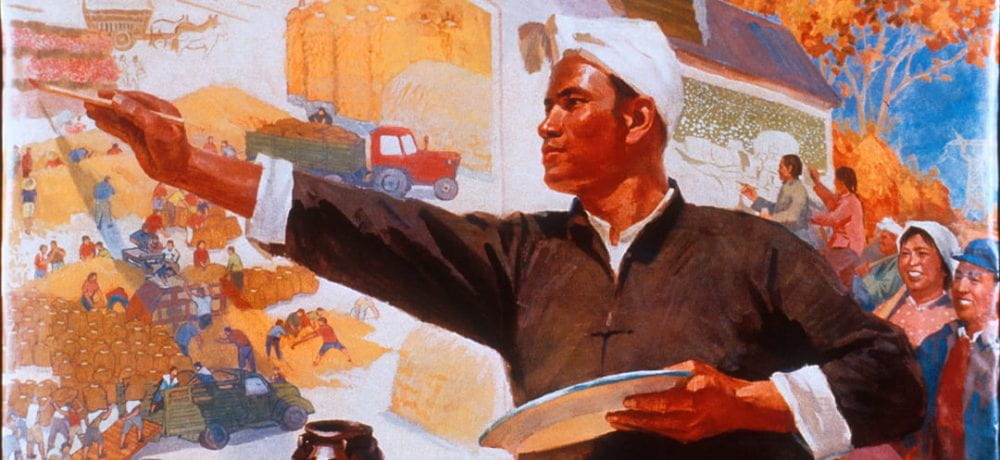Ding Cong, Images of Today, ink and opaque color on paper, 1944
In this painting, the medium used was a type of watercolor called gouache, which is similar to watercolor except for it is an opaque color that is thickened with a glue-like substance to give it a matte finish (Anderson, 2016). Key features of gouache is that the paint dries very quickly, and it allows artists to paint with great detail (Anderson, 2016). Above, the work is broken in half to fit the page, however it is one continuous canvas that is supposed to resemble a traditional scroll that Chinese artists used to paint on (Lullo, 2020). The content of this piece is a depiction of various individuals that are in their own “scene”, some are interacting with others, while some are alone. From top right to bottom left, there seems to be a general cycle of some academic people, spaced with some poor/injured people, followed by wealthy figures. The objective of this work is to shine a spotlight on what was then modern Chinese society, and this spotlight artistical is shown by having a white background with frames or “scenes” of figures that have seemingly been cut from whatever they were doing and placed into this painting. There is debate about the corruption of government during Chiang Kai-Shek’s rule through the 1940s, and while this painting does not directly represent this corruption, Ding does depict a very inequitable socioeconomic class structure of Chinese society. One key aspect that shows this is the woman with her child begging in the background for some food or money, while four wealthy men stand in front of her, paying her no attention. The ends of the piece show a man reading a book with his mouth covered, and a man walking with a newspaper in his mouth and a hand covering his eyes, and this could be interpreted as the truth about life in China being smothered by the government. One last thing to point out is the way each class is shown in relation to the viewer. The rich are prominently in the foreground, looking away from the viewer, while the poorer people show more of their faces, and are in the background. The man reading a book and the man holding his painting are facing the viewer, symbolizing the knowledge and truth of the corruptive government.
References:
Anderson, Madeline. “Watercolor and Gouache: What’s the Difference?” Escalette Permanent Collection of Art at Chapman University, 18 Feb. 2016, blogs.chapman.edu/collections/2016/02/18/watercolor-and-gouache-whats-the-difference/.
Lullo, Sheri. Class presentation. 2020.



Pointing out the difference in orientation in this painting is a very insightful analysis, as I believe that it characterizes quite well the priorities of the Nationalist government. As we saw in a number of woodcut paintings as well, the socioeconomic inequalities in KMT-governed China could not be overlooked, no matter how tall Shanghai’s skyscrapers stood. The KMT was eager to display the wealth and development experienced in China after they consolidated political power, yet were unsurprisingly reticent to expose the vast wealth inequalities which existed within the nation, particularly in urban areas. To supplement what you stated above, the wealthy and educated were often placed at the forefront of China’s national image, and in the background were those who did not benefit as much, or at all, from the KMT’s governance. In my future analyses of my artist’s works, Chen Danqing, I can employ the lens of viewing the work as a counternarrative to mainstream Chinese media and political discourse. As Chen paints extensively subjects and landscapes in the Tibetan Plateau, I now will be able to better understand the emphasis he places on normalcy and beneficial diversity to contrast with Beijing’s aggressive and confrontational stance taken towards the people and the region.
This painting by Ding Cong is vastly different and more detailed from my artist’s work. It is interesting how different artists and their styles can be, yet they are both portraying a powerful message to the viewer. Dan mentions that Ding used gouache, which allows the artists to be very detailed. As this painting shows, the detail is most important in depicting the different situations of each person in the painting. It is sending a message to the viewers about the reality of Chinese society during that time. This made me realize how little detail Feng Zikai used in the work I analyzed, but that he obviously does not need incredible detail to create a powerful image. On the other hand, in Ding Cong’s work, the detail played a huge part in the message and the representation of the Chinese people, and the message is just as powerful. I am interested to see and study even more of Feng’s work and what detail he uses, or lack there of to relay his message and views.